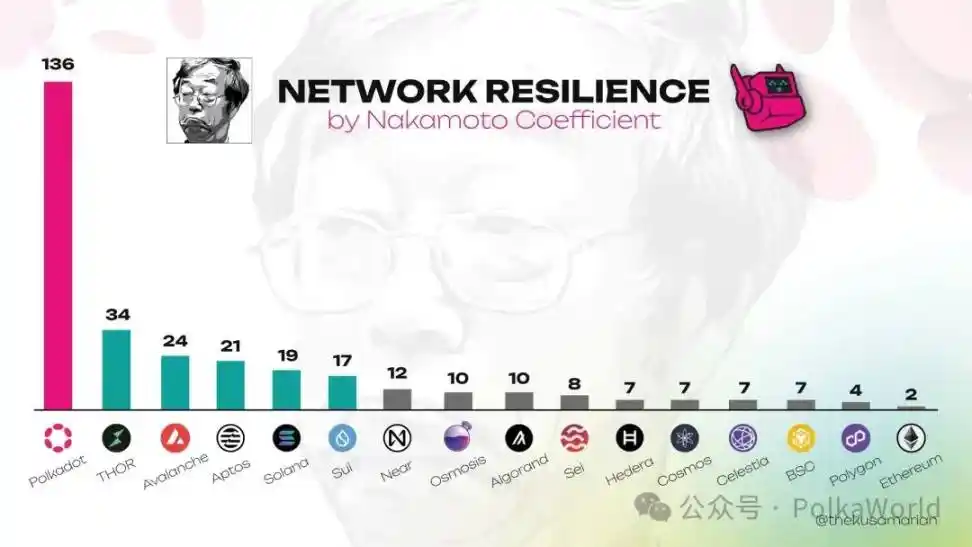What Makes Or Breaks A Blockchain: Gavin Wood’s 5 Criteria
Author: Marie Poteriaieva
Original compilation: OneBlock+
Putting aside market value and hype, what determines the long-term success of blockchain? Gavin Wood, co-founder of Ethereum, creator of the Web3 concept and creator of Polkadot, shared his assessment of blockchainFive key criteria。
withForbesIn an interview, Gavin Wood, a prophet in the crypto industry, explained what factors can make blockchain projects successful and what can cause them to fail. He also shared some useful evaluation criteria and provided a direct analysis of the most popular blockchain projects currently.
His analytical methods help us more clearly understand the price fluctuations of cryptocurrencies in leading blockchains. For example, why has ETH’s market value dropped from a high of US$575 billion in 2021 to US$394 billion now? Why did SOL’s market value break through an all-time high of $115 billion, while Polkadot’s DOT (launched around the same period) fell to $9 billion? Wood not only saw the numbers of these changes, but also identified the key reasons behind these changes.

Gavin Wood speaks at the Decided Conference in Brussels in July 2024
Gavin Wood’s five blockchain evaluation criteria
There are currently hundreds of blockchains, each with its own unique technology, application scenarios and usage situations. To help us see the real potential blockchains, Gavin Wood listed five basic criteria for evaluating them.
·Resilience:The cornerstone of Web3, resilience combines cryptography, decentralization, and game theory to protect blockchain from attacks and ensure its long-term stability.
·Performance:Not just scalability, performance measures how efficiently a network processes and completes tasks.
·Universality:Blockchain supports multiple applications and programmability capabilities.
·Accessibility:How easy it is for users, developers, applications, and robots to interact with the network.
·Consistency:A system’s ability to maintain rapid and consistent communication across its network.
Resilience: An uncompromising standard
Although blockchain can focus on different characteristics, there is one criterion that cannot be compromised, and that is decentralization and resilience. This criterion is difficult to evaluate and requires long-term attention, but it is the most important one.
Gavin Wood said:“Blockchains that ignore decentralization and resilience should not be called Web 3.”
He continued: “For example, we see that the L2 network on Ethereum has a fixed set of validators, and these validators are managed by a specific company, right?This is obviously not a feature of Web3.」
Assessing the resilience of a blockchain often boils down to assessing the degree of decentralization.Wood asked several questions to assess:
Who makes the agreed decision?
Does the governance structure have clear or low barriers to entry?
There is also the Nakamoto coefficient, which measures the number of participants needed to disrupt the network.
Finally, Wood raised a broader issue, such as whether there is a single entity that can dominate the direction of the entire project and “completely control the ecosystem and suppress other voices and opinions.”
Polkadot’s current Satoshi coefficient is 149This means that at least 149 independent validators need to join forces to disrupt the network. In comparison, some other major blockchains have much lower scores, such as Solana’s score of 19 and Ethereum’s score of only 2.

However, barriers to entry remain an issue.
Maurantonio Caprolu, a research scientist at KAUST in Saudi Arabia, who co-authored multiple papers on Polkadot with Professor Roberto Di Pietro, describes the high threshold for this issue.
“Until 2022, to become an active verifier, an average of approximately 1.8 million DOT would have to be pledged (approximately $32 million at the time). Even now, this minimum pledge requirement is still high and is actually more conducive to the participation of institutions that can bear large amounts of DOT token fees.”
Judging from the resilience standards defined by Gavin, Ethereum’s weaknesses become obvious.Ethereum is often criticized for Vitalik Buterin’s huge influence. Especially his recent post on X-“I am the one who decides the leadership team of the new EF (Ethereum Foundation)”-has escalated this controversy.

People may ask: Given Gavin Wood’s importance in Polkadot, does Polkadot also face the risk of Gavin dominating the narrative?Wood admitted that his name does carry weight, but emphasized that Polkadot’s governance is community-driven. He cited examples of successful community-led proposals, such as lowering DOT’s inflation rate, as evidence of Polkadot’s decentralized decision-making process.
The Polkassembly governance platform further promotes community participation and launches an OpenGov compliant framework in 2023. Caprolu and his team believe OpenGov can “expand inclusiveness and reduce concentration of power.” However, the researchers pointed out: “Because the system is still in its early stages, more time and data are needed to verify whether OpenGov can successfully mitigate the tendency towards centralization of power we observed in Governance 1.0, the governance model before Polkadot.”
Performance: At what cost?
Different blockchains adopt different strategies to improve performance, but the common challenge they face is how to improve performanceimprove performance、a decentralizedandconsistencyFind a balance between them.
Take Ethereum as an example. Wood explained: “Initially, they planned to use sharding technology to add EVM sharding to the network. But they later abandoned the solution and chose to support the L2 solution instead. In fact, they didn’t do anything but let others build chains and keep those chains safe through Ethereum.” This practice leads to a lack of consistency and even affects security.Wood believes that “Ethereum and L2 are not really Ethereum after being combined, because L2 does not provide the same security guarantees.”
In addition, Gavin believes that Solana sacrificed decentralization.
“Solana’s strategy is to make its validators stronger and ensure good connectivity between those validators. To achieve this goal, Solana reduced the number of validators. Because if you want to improve connectivity between two validators, you usually need to reduce the number of participating validators. As a result, Solana’s Nakamoto coefficient drops, because fewer validators mean fewer participants can control the network, reducing the degree of decentralization.”
Gavin Wood called Solana “A highly synchronized expansion strategy“, its speed is limited by the speed at which a single machine processes and synchronizes data. Although this approach can achieve rapid expansion at an early stage, it will eventually suffer from bottlenecks caused by hardware and network limitations.
For Wood,”the same goes for many other proof of stake chains. They don’t have a consistent scaling strategy, and in order to process more data, they just reduce the number of validators and increase the speed.”
Polkadot is built differently from Solana, it usesAdd more validators to expand and optimize the network。Specifically, Polkadot enhances decentralization by increasing the number of validators, rather than reducing them. By involving more validators, Polkadot not only remains decentralized, but also makes the network run faster. In other words, Polkadot optimizes performance by “scaling” rather than sacrificing decentralization to pursue speed.
Universality: True Turing Completeness
Gavin Wood defines the versatility of blockchain by measuring how easy it is to convert Web2 applications to Web3.More specifically, he measures versatility by how many different computing tasks the blockchain can support and how complex these computing tasks are.
Ethereum introduces the concept of Turing completeness, meaning that it can perform any computable task. But as Wood points out, Ethereum does not fully achieve this. This is because it is constrained by gas constraints and block size within which calculations must be done, which limits the scope of complex problems it can solve.
Polkadot aims to eliminate these constraints through its parallel chain model. Parallel chains perform their own logic in a WebAssembly environment, as long as calculations are completed in seconds. This setting allows parallel chains to process larger data sets. Currently, Ethereum allows about 15 million EVM gas per block, and for Polkadot, this figure is equivalent to 18 billion gas.
Still, Polkadot’s versatility, like Ethereum, is still quantitative rather than qualitative.It expands computing power but does not fundamentally change the scope of computing. With the upcoming JAM Upgrade, this situation will change. JAM upgrade promises to enable “the heritage and(continuations)”, meaning that calculations can be paused and resumed between blocks.
Professor Soulla Louca, head of the blockchain initiative at the University of Nicosia in Cyprus, believes thatRemoving the limitations of single-block computing could be a major breakthrough。She explained,
“While other blockchains have mechanisms for handling complex calculations (e.g., Layer Two Solutions, Optimistic Rollups), no other blockchains currently offer a built-in continuity mechanism similar to the one proposed by JAM.This capability could provide Polkadot with a significant advantage in supporting more complex and versatile applications, especially for more advanced applications such as complex financial instruments, large-scale data processing, and on-chain AI/ML.”
Consistency: Removing obstacles
Consistency is a major challenge facing the blockchain ecosystem.Both Ethereum’s L2 and Polkadot’s parallel chain have encountered difficulties in this regard。As Wood describes, they run in isolated environments, and cross-chain interactions are often slow, expensive and potentially unsafe unless a co-ordering system is introduced. However, this system also presents its own challenges, as it requires a supercomputer to sort, which inevitably leads to centralization.
Wood acknowledges that consistency is not Polkadot’s main focus. Although there have been some integrations and bridging in the past year, parallel chains still face consistency issues.
This issue was also pointed out by OriginTrail founder Tomaz Levak. His company has developed a DeSci (Decentralized Science) protocol designed to structure and connect real-world data for AI and enterprise applications, and runs on its own Polkadot parallel chain. Levak said that while “the performance and customization capabilities brought by Polkadot’s technology design are unique in meeting needs,” he would like to see “Strengthening bridging infrastructure between other blockchain ecosystems」。
Accessibility: Usability testing
In the blockchain field, the general view is that Polkadot technology is very powerful but difficult to understand. However, Wood pointed out that Polkadot’s accessibility has improved significantly over the past year thanks to upgrades to the XCM (Cross-Chain Messaging) system and ecological wallet. Similarly, Tomaz Levak said that OriginTrail end users “rarely interact directly with the blockchain layer because the friendly user interface ensures a smooth experience.”
Despite this, consistency issues remain, hindering accessibility. Wood said JAM will address this issue by providing shared data availability storage, where services can be built to completely hide consistency issues faced by users.
In terms of developer engagement, Wood is proud to point out that Polkadot has always ownedMany “serious” full-time developers。In fact, Electric Capital’s developer report shows that Polkadot’s technology stack ranks third in the crypto space. Currently, Polkadot has 467 full-time developers, behind Solana (599) and Ethereum (3562). However, Wood believes the actual number is higher because of the fact that people working on JAM 35 teamsIn a closed source environment and not included in the report.
In general, no blockchain currently can perfectly grasp these five standards. As Gavin Wood said:
“Some blockchain systems perform very well but lack consistency, such as Polkadot。Blockchains like Ethereum perform well in terms of consistency, but perform poorly. if you look at Solana, it does a good job of consistency, but lacks resilience and decentralization. So, the current situation is that you can choose some of these features, but no blockchain can meet all of these needs at the same time.”
The real winners will be those blockchains that adapt to change without compromising the core principles of Web3.The question is: Which blockchain will find balance first?
original link



